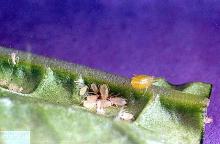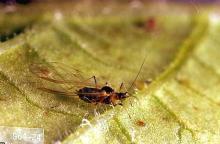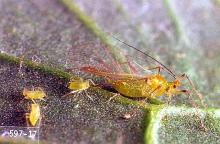Includes
Green peach aphid (Myzus persicae)
Potato aphid (Macrosiphum euphorbiae)
Note: Over 30 species of aphids can be found in potato fields; many are considered non-colonizing.
Pest description and crop damage Aphids are soft-bodied insects with a pair of abdominal cornicles that exude sugary droplets. Green peach aphid and potato aphids are the two most common aphid species in potato. The potato aphid is more common in the spring and fall, while the green peach aphid peaks during July and early August. Large populations of aphids can cause yield reductions through direct feeding, but their principal economic impact is due to their ability to transmit plant viruses such as potato leaf roll virus (PLRV) and potato virus Y (PVY).
PLRV (Luteoviridae: Polerovirus) causes tuber symptoms in some varieties called tuber net necrosis. This internal tuber discoloration is not acceptable in the marketplace. Foliar symptoms occur in younger leaves where leaf margins become necrotic, turn brown and purplish, and curl inwards. PLRV is transmitted in a persistent manner, meaning that an aphid that has acquired the virus can transmit it to uninfected plants for the rest of its life. Persistent viruses require a latent period within the aphid before they can be transmitted. The low tolerance in the marketplace for net necrosis, and the high vectoring capacity of green peach aphid, means there is a very low treatment threshold for this pest. PLRV has not been a substantial problem since neonicotinoids have been used in potatoes.
Potato virus Y (PVY) (Potyvirudae: Potyvirus) is a serious disease in potato production in the PNW. New strains of PVY that cause transient foliar symptoms with internal brown lesions in tubers are becoming common. This damage is unacceptable in the marketplace. PVY is transmitted by many different aphid species in a non-persistent manner, which means that aphids probing an infected potato plant acquire the virus, then when moving to a non-infected plant, they inoculate it mechanically with the virus. There is no latent period. PVY is transmitted very quickly-in a far shorter time than most insecticides can act to prevent aphid feeding. This, and the fact that most PVY transmission is by non-colonizing aphids (those that do not live in the potato field), means that PVY control with insecticides is poor at best.
Biology and life history Winged green peach aphids arrive on potatoes in the spring from weeds and various crops where they overwintered as nymphs and adults. Potato aphids overwinter as nymphs, adults, or eggs; eggs are laid on roses and other plants. Both species feed on many crops, weeds, and native plants. Throughout the growing season, aphids produce live young, all of which are female and can be either winged or wingless. Winged aphids tend to be produced more when colonies become crowded. In the fall, winged males are produced which fly to overwintering hosts and mate with egg-laying females produced on that host. Both species of aphids found on PNW potatoes undergo multiple overlapping generations per year.
Scouting and thresholds Fields should be checked for aphids at least weekly starting shortly after potato emergence. When plants are upright, the most effective scouting method is to shake plants above beating sheets, beating trays, or half gallon ice cream buckets. In some varieties, the vines become very long, lie down on the soil, and become intertwined, making beating sheets or buckets difficult to use. In this case, a leaf sampling scheme might be useful. Field scouts can also use a bucket trapping technique (https://aphidtrek.org/?page_id=1295). There are no well-established treatment thresholds for aphids on potato in the PNW, however seed potato fields require a particularly low treatment threshold.
Management-biological control
Potatoes can harbor large numbers of generalist predators that feed on aphids. These include the Hemipteran bugs: pirate bugs (Orius spp.), big-eyed bugs (Geocoris spp.), and damsel bugs (Nabis spp.). Other common aphid predators include lady beetles and their larvae, lacewings, and flower fly larvae. Aphid-specific parasitoid wasps can also be common in potato fields that are not heavily treated with insecticides.
Management-cultural control
The most important source of virus in a potato field is infected potato plants. Therefore, purchasing certified seed with low or no virus infection is the best first step in controlling aphid-related damage to potatoes. Controlling other sources of virus inoculum such as cull piles and volunteer potatoes is also important.
Management-chemical control: HOME USE
- acetamiprid
- azadirachtin (neem oil)-Some formulations are OMRI-listed for organic use.
- carbaryl
- cyfluthrin
- deltamethrin
- esfenvalerate
- insecticidal soap-Some formulations OMRI-listed for organic use.
- kaolin-As a spray to foliage and stems it acts as a repellent to some insect pests. Some formulations are OMRI-listed for organic use.
- malathion
- plant essential oils (clove, garlic, rosemary etc.)-Some formulations are OMRI-listed for organic use.
- permethrin
- pyrethrins (often as a mix with other ingredients)-Some formulations are OMRI-listed for organic use.
- zeta-cypermethrin
Management-chemical control: COMMERCIAL USE
When used to control other pests, pyrethroid (Group 3 in Tables 1-2) applications make aphid management more difficult. Pyrethroids eliminate aphid predators and parasitoids which naturally control pests in the field. Data show that early applications of pyrethroids cause flare-ups of not only aphids, but other pests such as mites and thrips. When possible, it is best to use aphid insecticides with narrow spectra of control and avoid package mixes (Table 2) and other products that kill beneficials.
See:





